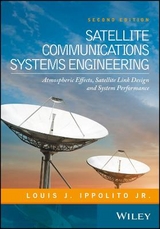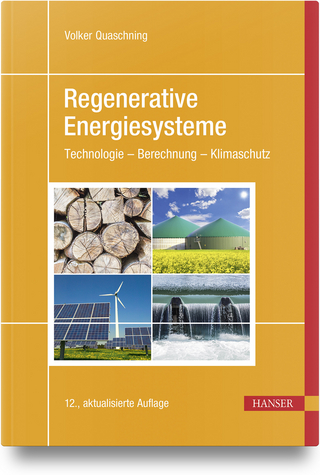
Satellite Communications Systems Engineering
Wiley-Blackwell (Verlag)
978-0-470-72527-6 (ISBN)
- Titel erscheint in neuer Auflage
- Artikel merken
Key features: Provides the state of the art in communications satellite link design and performance from the practicing engineer perspective - concise descriptions, specific procedures and comprehensive solutions Contains the calculations and tools necessary for evaluating system performance Provides a complete evaluation of atmospheric effects, modelling and prediction Focuses on the satellite free-space link as the primary element in the design and performance for satellite communications, and recognizes the importance of free-space considerations such as atmospheric effects, frequency of operation and adaptive mitigation techniques a solutions manual is available directly from the author ( lippolit@gwu.edu )
Dr. Louis Ippolito Jr, Herndon, US has over thirty-five years experience in satellite communication systems, radiowave propagation studies, experiments and analysis, and the development, design, and implementation of satellite and terrestrial wireless systems. He is a recognized international expert on the effects of the Earth's atmosphere on space communications. He is the author of over sixty technical publications, including the books Radiowave Propagation in Satellite Communications Systems , Van Nostrand Reinhold, 1986, Propagation Effects Handbook for Satellite Systems Design , NASA JPL Ref. Pub. 1082(5), April 2000, and contributions to The Communications Handbook , J.D. Gibson Editor, CRC Press, 1997 and 2002, and Satellite Communications, Global Change Agents , Lawrence Erlbaum Associates, 2004.
List of Acronyms. Preface. Chapter 1 Introduction to Satellite Communications. 1.1 Early History of Satellite Communications. 1.2 Some Basic Communications Satellite System Definitions. 1.3 Regulatory Process for Satellite Communications. 1.4 Overview of Book Structure and Topics. References. Chapter 2 Satellite Orbits. 2.1 Kepler's Laws. 2.2 Orbital Parameters. 2.3 Orbits in Common Use. 2.4 Geometry of GSO Links. References. Problems. Chapter 3 Satellite Subsystems. 3.1 Satellite Bus. 3.2 Satellite Payload. References. Chapter 4 The RF Link. 4.1 Transmission Fundamentals. 4.2 System Noise. 4.3 Link Performance Parameters. References. Problems. Chapter 5 Link System Performance. 5.1 Link Considerations. 5.2 Uplink. 5.3 Downlink. 5.4 Percent of Time Performance Specifications. References. Problems. Chapter 6 Transmission Impairments. 6.1 Radiowave Frequency and Space Communications. 6.2 Radiowave Propagation Mechanisms. 6.3 Propagation Below About 3 GHz. 6.4 Propagation Above About 3 GHz. 6.5 Radio Noise. References. Problems. Chapter 7 Propagation Effects Modeling and Prediction. 7.1 Atmospheric Gases. 7.2 Clouds and Fog. 7.3 Rain Attenuation. 7.4 Depolarization. 7.5 Tropospheric Scintillation. References. Problems. Chapter 8 Rain Fade Mitigation. 8.1 Power Restoral Techniques. 8.2 Signal Modification Restoral Techniques. 8.3 Summary. References. Problems. Chapter 9 The Composite Link. 9.1 Frequency Translation (FT) Satellite. 9.2 On-Board Processing (OBP) Satellite. 9.3 Comparison of FT and OBP Performance. 9.4 Intermodulation Noise. 9.5 Link Design Summary. References. Problems. Chapter 10 Satellite Multiple Access. 10.1 Frequency Division Multiple Access. 10.2 Time Division Multiple Access. 10.3 Code Division Multiple Access. References. Problems. Chapter 11 The Mobile Satellite Channel. 11.1 Mobile Channel Propagation. 11.2 Narrowband Channel. 11.3 Wideband Channel. 11.4 Multi-Satellite Mobile Links. References. Appendix A Satellite Signal Processing Elements. A.1 Analog Systems. A.2 Digital Baseband Formatting. A.3 Digital Source Combining. A.4 Digital Carrier Modulation. A.5 Summary. References. Appendix B Error Functions and Bit Error Rate. B.1 Error Functions. B.2 Approximation for BER. Index.
| Reihe/Serie | Wireless Communications and Mobile Computing |
|---|---|
| Zusatzinfo | Illustrations |
| Verlagsort | Hoboken |
| Sprache | englisch |
| Maße | 177 x 247 mm |
| Gewicht | 818 g |
| Themenwelt | Technik ► Elektrotechnik / Energietechnik |
| Technik ► Nachrichtentechnik | |
| ISBN-10 | 0-470-72527-3 / 0470725273 |
| ISBN-13 | 978-0-470-72527-6 / 9780470725276 |
| Zustand | Neuware |
| Informationen gemäß Produktsicherheitsverordnung (GPSR) | |
| Haben Sie eine Frage zum Produkt? |
aus dem Bereich



